Exercise-1.1
- Is zero a rational number? Can you write it in the form p/q, where p and q are integers and q ≠0? Yes, zero is a rational number; it can be written in the form p/q.0 = 0/1 = 0/2 = 0/3
- Find six rational numbers between 3 and 4.
Let qi be the rational number between 3
and 4, where j = 1 to 6.
∴ Six rational numbers are as follows: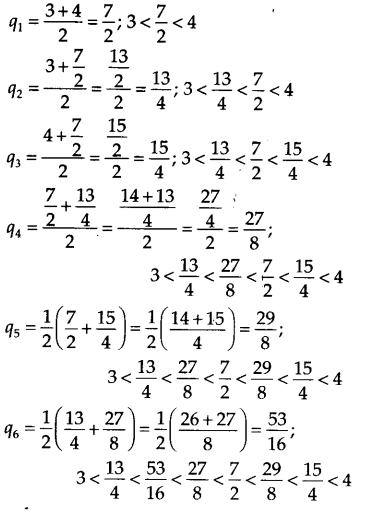
3. Find five rational numbers between 3/5 and 4/5.
Since we need to find five rational numbers, therefore, multiply the numerator and denominator by 6.

4. State whether the following statements are true or false. Give reasons for your answers.
(i)Every natural number is a whole number.
(ii) Every integer is a whole number.
(iii) Every rational number is a whole number.
(i) True
∵ The collection of all natural numbers and 0 is called whole numbers.
(ii) False
∵ Negative integers are not whole numbers.
(iii) False
∵ Rational numbers are of the form p/q, q ≠ 0 and q does not divide completely; that are not whole numbers.
Exercise-1.2
- State whether the following statements are true or false. Justify your answers.
(i)Every irrational number is a real number.
(ii) Every point on the number line is of the form √m , where m is a natural number.
(iii) Every real number is an irrational number.
(i) True
Because all rational numbers and all irrational numbers form the group (collection) of real numbers.
(ii) False
Because negative numbers cannot be the square root of any natural number.
(iii) False
Because rational numbers are also part of real numbers.
2. Are the square roots of all positive integers irrational? If not, give an example of the square root of a number that is a rational number.
No, if we take a positive integer, say 9, its square root is 3, which is a rational number.
Now draw BB1 ⊥ OB such that BB1 =1 unit. Join OB1 = √3 units.
Next, draw B1B2⊥ OB1such that B1B2 = 1 unit.
Join OB2 = units.
Again draw B2B3 ⊥OB2 such that B2B3 = 1 unit.
Join OB3 = √5 units.
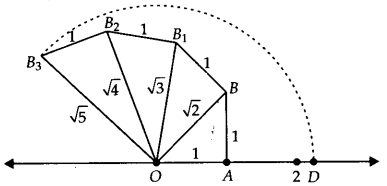
Take O as centre and OB3 as radius, draw an arc which cuts the number line at D.
Point D
represents √5 on the number line.
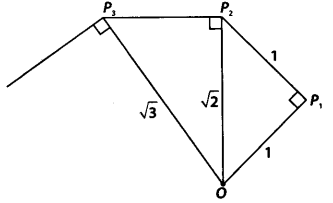
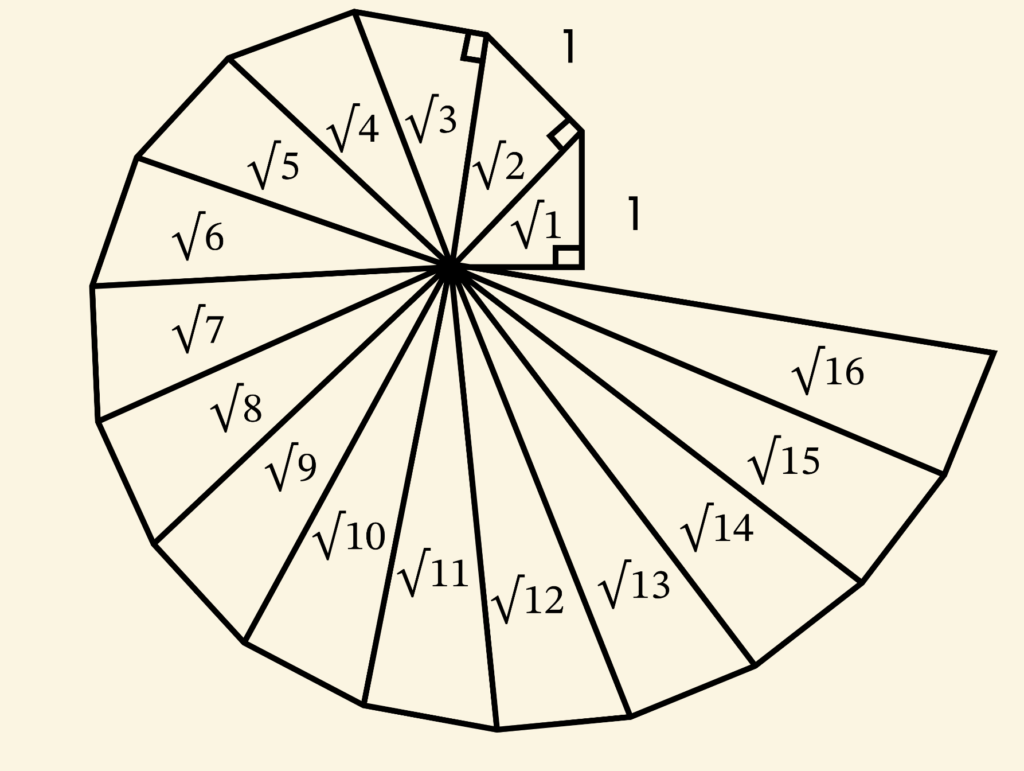
Step 1: Mark a point O
Choose a point O on your paper. This will be the centre of your square root spiral.
Step 2: Draw line OA of 1 cm horizontally
From point O, draw a straight line OA horizontally to the right. The length should be 1 cm.
Step 3: Draw perpendicular line AB of 1 cm
From point A (the end of OA), draw a line AB vertically upwards. The length of AB should also be 1 cm.
Step 4: Join OB (length √2)
Join point O to point B (the end of AB). The length of OB should be √2 cm.
Step 5: Draw perpendicular line from B and mark C
From point B, draw another line perpendicular to OB (going upwards) of 1 cm. Mark the endpoint of this line as C.
Step 6: Join OC (length √3)
Join point O to point C. The length of OC should be √3 cm.
Step 7: Repeat the process
Repeat steps 5 and 6 to continue the spiral:
From point C, draw a perpendicular line of 1 cm upwards and mark the endpoint as D.
Join O to D. The length OD should be √4 cm.
Continue this process, each time increasing the length of the perpendicular line by 1 cm and joining the new point to O to form the next segment of the spiral, where the length of each segment from O increases by 1 each time (resulting in √2, √3, √4, etc.).
Exercise-1.3
1.Write the following in decimal form and say what kind of decimal expansion each has
![]()
Ans: (i) Divide 36 by 100.
So, 36/100=0.36 and it is a terminating decimal number.
(ii) Dividing 1 by 11, we have
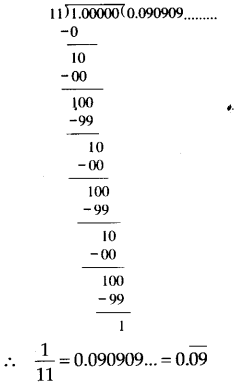
Thus, the decimal expansion of 1/11 is non-terminating repeating.
(iii) We have 4 1/8 = 33/8
Dividing 33 by 8, we get
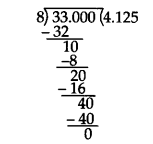
∴ 4 1/8 = 4.125. Thus, the decimal expansion is terminating.
(iv) Dividing 3 by 13, we get
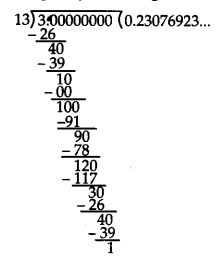
Here, the repeating block of digits is 230769
∴ 3/13 = 0.23076923… = 0.230769¯
Thus, the decimal expansion of 3/13 is non-terminating repeating.
(v) Dividing 2 by 11, we get
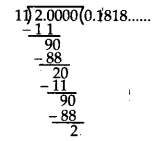
Here, the repeating block of digits is 18.
∴ 2/11 = 0.1818… = 0.18¯
Thus, the decimal expansion of 2/11 is non-terminating repeating.
(vi) Dividing 329 by 400, we get
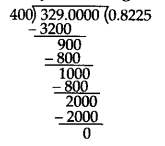
329/400 = 0.8225. Thus, the decimal expansion of 329/400 is terminating.
2. You know that 1/7 = 0.142857. Can you predict what the decimal expansions of 2/7, 3/7, 4/7, 5/7, and 6/7 are without actually doing the long division? If so, how?
[Hint: Study the remainders carefully while finding the value of 1/7 .]
Ans:

3. Express the following in the form p/q, where p and q are integers and q ≠ 0.
(i) 
Ans:

Assume that x = 0.666…
Then,10x = 6.666…
10x = 6 + x
9x = 6
x = 2/3

Ans:

= (4/10)+(0.777/10)
Assume that x = 0.777…
Then, 10x = 7.777…
10x = 7 + x
x = 7/9
(4/10)+(0.777../10) = (4/10)+(7/90) ( x = 7/9 and x = 0.777…0.777…/10 = 7/(9×10) = 7/90 )
= (36/90)+(7/90) = 43/90

Ans:

Assume that x = 0.001001…
Then, 1000x = 1.001001…
1000x = 1 + x
999x = 1
x = 1/999
4. Express 0.99999…. in the form p/q. Are you surprised by your answer? With your teacher and classmates, discuss why the answer makes sense.
Ans:
Assume that x = 0.9999…..Eq (a)
Multiplying both sides by 10,
10x = 9.9999…. Eq. (b)
Eq.(b) – Eq.(a), we get
10x = 9.9999…
-x = -0.9999…
___________
9x = 9
x = 1
The difference between 1 and 0.999999 is 0.000001, which is negligible.
Hence, we can conclude that 0.999 is too much near 1; therefore, 1 as the answer can be justified.
5. What can the maximum number of digits be in the repeating block of digits in the decimal expansion of 1/17? Perform the division to check your answer.
Ans:
1/17
Dividing 1 by 17:


There are 16 digits in the repeating block of the decimal expansion of 1/17.
6. Look at several examples of rational numbers in the form p/q (q ≠ 0), where p and q are integers with no common factors other than 1 and have terminating decimal representations (expansions). Can you guess what property q must satisfy?
Ans:
We observe that when q is 2, 4, 5, 8, 10… Then the decimal expansion terminates. For example:
1/2 = 0. 5, denominator q = 21
7/8 = 0. 875, denominator q =23
4/5 = 0. 8, denominator q = 51
We can observe that the terminating decimal may be obtained in the situation where the prime factorisation of the denominator of the given fractions has the power of only 2 or only 5 or both.
7. Write three numbers whose decimal expansions are non-terminating and non-recurring.
Ans:
We know that all irrational numbers are non-terminating and non-recurring. The three numbers with decimal expansions that are non-terminating and non-recurring are:
- √3 = 1.732050807568
- √26 =5.099019513592
- √101 = 10.04987562112
8. Find three different irrational numbers between the rational numbers 5/7 and 9/11.
Ans:

Three different irrational numbers are:
- 0.73073007300073000073…
- 0.75075007300075000075…
- 0.76076007600076000076…
9. Classify the following numbers as rational or irrational according to their type:
(i)√23
Ans:
√23 = 4.79583152331…
Since the number is non-terminating and non-recurring, it is an irrational number.
(ii)√225
Ans:
√225 = 15 = 15/1
Since the number can be represented in p/q form, it is a rational number.
(iii) 0.3796
Ans:
Since the number,0.3796, is terminating, it is a rational number.
(iv) 7.478478
Ans:
The number 7.478478at is non-terminating but recurring; hence, it is a rational number.
(v) 1.101001000100001…
Ans:
Since the number 1.101001000100001… is non-terminating and non-repeating (non-recurring), it is an irrational number.
Exercise-1.4
1. Classify the following numbers as rational or irrational:
(i) 2 –√5
Ans:
We know that √5 = 2.2360679…
Here, 2.2360679…is non-terminating and non-recurring.
Now, substituting the value of √5 in 2 –√5, we get,
2-√5 = 2-2.2360679… = -0.2360679
Since the number – 0.2360679… is non-terminating non-recurring, 2 –√5 is an irrational number.
(ii) (3 +√23)- √23
Ans:
(3 +√23) –√23 = 3+√23–√23
= 3
= 3/1
Since the number 3/1 is in p/q form, (3 +√23)- √23 is rational.
(iii) 2√7/7√7
Ans:
2√7/7√7 = ( 2/7)× (√7/√7)
We know that (√7/√7) = 1
Hence, ( 2/7)× (√7/√7) = (2/7)×1 = 2/7
Since the number 2/7 is in p/q form, 2√7/7√7 is rational.
(iv) 1/√2
Ans:
Multiplying and dividing the numerator and denominator by √2, we get,
(1/√2) ×(√2/√2)= √2/2 ( since √2×√2 = 2)
We know that √2 = 1.4142…
Then, √2/2 = 1.4142/2 = 0.7071..
Since the number 0.7071… is non-terminating non-recurring, 1/√2 is an irrational number.
(v) 2π
Ans:
We know that the value of = 3.1415
Hence, 2 = 2×3.1415.. = 6.2830…
Since the number 6.2830… is non-terminating non-recurring, 2 is an irrational number.
2. Simplify each of the following expressions:
(i) (3+√3)(2+√2)
Ans:
(3+√3)(2+√2 )
Opening the brackets, we get, (3×2)+(3×√2)+(√3×2)+(√3×√2)
= 6+3√2+2√3+√6
(ii) (3+√3)(3-√3 )
Ans:
(3+√3)(3-√3 ) = 32-(√3)2 = 9-3
= 6
(iii) (√5+√2)2
Ans:
(√5+√2)2 = √52+(2×√5×√2)+ √22
= 5+2×√10+2 = 7+2√10
(iv) (√5-√2)(√5+√2)
Ans:
(√5-√2)(√5+√2) = (√52-√22) = 5-2 = 3
3. Recall, π is defined as the ratio of the circumference (say c) of a circle to its diameter, (say d). That is, π =c/d. This seems to contradict the fact that π is irrational. How will you resolve this contradiction?
Ans:
There is no contradiction. When we measure a value with a scale, we only obtain an approximate value. We never obtain an exact value. Therefore, we may not realize whether c or d is irrational. The value of π is almost equal to 22/7 or 3.142857…
4. Represent (√9.3) on the number line.
Ans:
Step 1: Draw a 9.3 units long line segment, AB. Extend AB to C such that BC=1 unit.
Step 2: Now, AC = 10.3 units. Let the centre of AC be O.
Step 3: Draw a semi-circle of radius OC with centre O.
Step 4: Draw a BD perpendicular to AC at point B intersecting the semicircle at D. Join OD.
Step 5: OBD, obtained, is a right-angled triangle.
Here, OD 10.3/2 (radius of semi-circle), OC = 10.3/2 , BC = 1
OB = OC – BC
⟹ (10.3/2)-1 = 8.3/2
Using Pythagoras’ theorem,
We get,
OD2=BD2+OB2
⟹ (10.3/2)2 = BD2+(8.3/2)2
⟹ BD2 = (10.3/2)2-(8.3/2)2
⟹ (BD)2 = (10.3/2)-(8.3/2)(10.3/2)+(8.3/2)
⟹ BD2 = 9.3
⟹ BD = √9.3
Thus, the length of BD is √9.3.
Step 6: Taking BD as the radius and B as the centre, draw an arc which touches the line segment. The point where it touches the line segment is at a distance of √9.3 from O, as shown in the figure.

5. Rationalize the denominators of the following:
(i) 1/√7
Ans:
Multiply and divide 1/√7 by √7
(1×√7)/(√7×√7) = √7/7
(ii) 1/(√7-√6)
Ans:
Multiply and divide 1/(√7-√6) by (√7+√6)
[1/(√7-√6)]×(√7+√6)/(√7+√6) = (√7+√6)/(√7-√6)(√7+√6)
= (√7+√6)/√72-√62 [denominator is obtained by the property, (a+b)(a-b) = a2-b2]
= (√7+√6)/(7-6)
= (√7+√6)/1
= √7+√6
(iii) 1/(√5+√2)
Ans:
Multiply and divide 1/(√5+√2) by (√5-√2)
[1/(√5+√2)]×(√5-√2)/(√5-√2) = (√5-√2)/(√5+√2)(√5-√2)
= (√5-√2)/(√52-√22) [denominator is obtained by the property, (a+b)(a-b) = a2-b2]
= (√5-√2)/(5-2)
= (√5-√2)/3
(iv) 1/(√7-2)
Ans:
Multiply and divide 1/(√7-2) by (√7+2)
1/(√7-2)×(√7+2)/(√7+2) = (√7+2)/(√7-2)(√7+2)
= (√7+2)/(√72-22) [denominator is obtained by the property, (a+b)(a-b) = a2-b2]
= (√7+2)/(7-4)
= (√7+2)/3
Exercise-1.5
Ans:
641/2 = (8×8)1/2
= (82)½
= 81 [⸪2×1/2 = 2/2 =1]
= 8
(ii)321/5
Ans:
321/5 = (25)1/5
= (25)⅕
= 21 [⸪5×1/5 = 1]
= 2
(iii)1251/3
Ans:
(125)1/3 = (5×5×5)1/3
= (53)⅓
= 51 (3×1/3 = 3/3 = 1)
= 5
2. Find:
(i) 93/2
Ans:
93/2 = (3×3)3/2
= (32)3/2
= 33 [⸪2×3/2 = 3]
=27
(ii) 322/5
Ans:
322/5 = (2×2×2×2×2)2/5
= (25)2⁄5
= 22 [⸪5×2/5= 2]
= 4
(iii)163/4
Ans:
163/4 = (2×2×2×2)3/4
= (24)3⁄4
= 23 [⸪4×3/4 = 3]
= 8
(iv) 125-1/3
125-1/3 = (5×5×5)-1/3
= (53)-1⁄3
= 5-1 [⸪3×-1/3 = -1]
= 1/5
3. Simplify:
(i) 22/3×21/5
Ans:
22/3×21/5 = 2(2/3)+(1/5) [⸪Since, am×an=am+n____ Laws of exponents]
= 213/15 [⸪2/3 + 1/5 = (2×5+3×1)/(3×5) = 13/15]
(ii) (1/33)7
Ans:
(1/33)7 = (3-3)7 [⸪Since,(am)n = am x n____ Laws of exponents]
= 3-21
(iii) 111/2/111/4
Ans:
111/2/111/4 = 11(1/2)-(1/4)
= 111/4 [⸪(1/2) – (1/4) = (1×4-2×1)/(2×4) = 4-2)/8 = 2/8 = ¼ ]
(iv) 71/2×81/2
Ans:
71/2×81/2 = (7×8)1/2 [⸪Since, (am×bm = (a×b)m ____ Laws of exponents]
= 561/2
